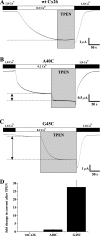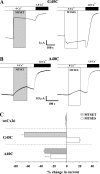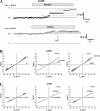Differentially altered Ca2+ regulation and Ca2+ permeability in Cx26 hemichannels formed by the A40V and G45E mutations that cause keratitis ichthyosis deafness syndrome
- PMID: 20584891
- PMCID: PMC2894548
- DOI: 10.1085/jgp.201010433
Differentially altered Ca2+ regulation and Ca2+ permeability in Cx26 hemichannels formed by the A40V and G45E mutations that cause keratitis ichthyosis deafness syndrome
Abstract
Mutations in GJB2, which encodes Cx26, are one of the most common causes of inherited deafness in humans. More than 100 mutations have been identified scattered throughout the Cx26 protein, most of which cause nonsyndromic sensorineural deafness. In a subset of mutations, deafness is accompanied by hyperkeratotic skin disorders, which are typically severe and sometimes fatal. Many of these syndromic deafness mutations localize to the amino-terminal and first extracellular loop (E1) domains. Here, we examined two such mutations, A40V and G45E, which are positioned near the TM1/E1 boundary and are associated with keratitis ichthyosis deafness (KID) syndrome. Both of these mutants have been reported to form hemichannels that open aberrantly, leading to "leaky" cell membranes. Here, we quantified the Ca(2+) sensitivities and examined the biophysical properties of these mutants at macroscopic and single-channel levels. We find that A40V hemichannels show significantly impaired regulation by extracellular Ca(2+), increasing the likelihood of aberrant hemichannel opening as previously suggested. However, G45E hemichannels show only modest impairment in regulation by Ca(2+) and instead exhibit a substantial increase in permeability to Ca(2+). Using cysteine substitution and examination of accessibility to thiol-modifying reagents, we demonstrate that G45, but not A40, is a pore-lining residue. Both mutants function as cell-cell channels. The data suggest that G45E and A40V are hemichannel gain-of-function mutants that produce similar phenotypes, but by different underlying mechanisms. A40V produces leaky hemichannels, whereas G45E provides a route for excessive entry of Ca(2+). These aberrant properties, alone or in combination, can severely compromise cell integrity and lead to increased cell death.
Figures









Similar articles
-
Aberrant hemichannel properties of Cx26 mutations causing skin disease and deafness.Am J Physiol Cell Physiol. 2007 Jul;293(1):C337-45. doi: 10.1152/ajpcell.00626.2006. Epub 2007 Apr 11. Am J Physiol Cell Physiol. 2007. PMID: 17428836
-
Altered inhibition of Cx26 hemichannels by pH and Zn2+ in the A40V mutation associated with keratitis-ichthyosis-deafness syndrome.J Biol Chem. 2014 Aug 1;289(31):21519-32. doi: 10.1074/jbc.M114.578757. Epub 2014 Jun 17. J Biol Chem. 2014. PMID: 24939841 Free PMC article.
-
Conserved glycine at position 45 of major cochlear connexins constitutes a vital component of the Ca²⁺ sensor for gating of gap junction hemichannels.Biochem Biophys Res Commun. 2013 Jul 5;436(3):424-9. doi: 10.1016/j.bbrc.2013.05.118. Epub 2013 Jun 10. Biochem Biophys Res Commun. 2013. PMID: 23756814
-
Aberrant Cx26 hemichannels and keratitis-ichthyosis-deafness syndrome: insights into syndromic hearing loss.Front Cell Neurosci. 2014 Oct 27;8:354. doi: 10.3389/fncel.2014.00354. eCollection 2014. Front Cell Neurosci. 2014. PMID: 25386120 Free PMC article. Review.
-
Pathological hemichannels associated with human Cx26 mutations causing Keratitis-Ichthyosis-Deafness syndrome.Biochim Biophys Acta. 2012 Aug;1818(8):2014-9. doi: 10.1016/j.bbamem.2011.09.003. Epub 2011 Sep 10. Biochim Biophys Acta. 2012. PMID: 21933663 Free PMC article. Review.
Cited by
-
Insights on the mechanisms of Ca(2+) regulation of connexin26 hemichannels revealed by human pathogenic mutations (D50N/Y).J Gen Physiol. 2013 Jul;142(1):23-35. doi: 10.1085/jgp.201210893. J Gen Physiol. 2013. PMID: 23797420 Free PMC article.
-
GJB2 Gene Mutations in Syndromic Skin Diseases with Sensorineural Hearing Loss.Curr Genomics. 2011 Nov;12(7):475-785. doi: 10.2174/138920211797904098. Curr Genomics. 2011. PMID: 22547955 Free PMC article.
-
Connexins in epidermal health and diseases: insights into their mutations, implications, and therapeutic solutions.Front Physiol. 2024 May 7;15:1346971. doi: 10.3389/fphys.2024.1346971. eCollection 2024. Front Physiol. 2024. PMID: 38827992 Free PMC article. Review.
-
Mechanism of gating by calcium in connexin hemichannels.Proc Natl Acad Sci U S A. 2016 Dec 6;113(49):E7986-E7995. doi: 10.1073/pnas.1609378113. Epub 2016 Nov 21. Proc Natl Acad Sci U S A. 2016. PMID: 27872296 Free PMC article.
-
Role of ROS/RNS in Preeclampsia: Are Connexins the Missing Piece?Int J Mol Sci. 2020 Jun 30;21(13):4698. doi: 10.3390/ijms21134698. Int J Mol Sci. 2020. PMID: 32630161 Free PMC article. Review.
References
-
- Bikle D.D., Chang S., Crumrine D., Elalieh H., Man M.Q., Dardenne O., Xie Z., Arnaud R.S., Feingold K., Elias P.M. 2004. Mice lacking 25OHD 1alpha-hydroxylase demonstrate decreased epidermal differentiation and barrier function. J. Steroid Biochem. Mol. Biol. 89-90:347–353 10.1016/j.jsbmb.2004.03.113 - DOI - PubMed
Publication types
MeSH terms
Substances
Grants and funding
LinkOut - more resources
Full Text Sources
Other Literature Sources
Medical
Miscellaneous

